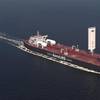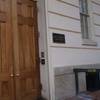Kearsarge Ready to Sail
By Chief Journalist Dave Nagle, USS Kearsarge Public Affairs
Four months, hundreds of maintenance and modernization items and countless training hours later, USS Kearsarge (LHD 3) returned to Naval Station Norfolk following the completion of sea trials April 26-28.
The sea trials were the capstone event of Kearsarge’s planned maintenance availability that began Jan. 12 at Norfolk Naval Shipyard.
During its three days at sea, Kearsarge conducted a Level I flex test for both boilers, full power demonstration, ballast/deballast tests and anchor tests, as well as tests and calibrations on its radar and electronics systems.
“Sea trials is our opportunity to test all systems that were worked on during the yard period and all integrated and interconnected systems to ensure operability,” said Ensign John St. John, the ship’s electronic maintenance officer.
Although shipyard workers and contractors performed the majority of the maintenance, Team Kearsarge was not idle. The crew completed a number of ship’s force work items, while hundreds others used the time in the shipyard to attend schools and training, to attain or maintain their professional and tactical proficiency.
“We took full advantage of the shipyard period to send all of the available aerographer’s mates through platform-specific course and team trainers here in the local area,” said Aerographer's Mate 1st Class (AW/SW) Chad Swick, OA Division’s leading petty officer. “It was a highly valuable opportunity to both train our junior personnel, and to get our forecasters and technicians working together to build team cohesiveness in order to provide services when we’re under way.”
Much of the training aboard ship focused on damage control and firefighting training. In addition to weekly repair locker training, the crew participated in main space fire and total ship survivability exercise drills three times a week. These drills honed the crew’s skills to combat a major fire in either of the ship’s two boiler rooms.
Storekeeper Seaman Katarina Loncar of supply department’s S-8 division said the aggressive training and drilling helped her in her ability to respond to a major emergency.
“When I first arrived on the ship seven months ago, I was confused and had no clue what was going on,” Loncar said. “The damage controlmen and the experienced people in the repair locker explained everything in a step-by-step way and showed me how to do things.
“Now, I’m very confident that when we go to GQ [general quarters], I’m ready to respond.”
With the shipyard availability and sea trials behind them, Kearsarge and its crew have begun the series of training evolutions and assessments in preparation for their next deployment.










